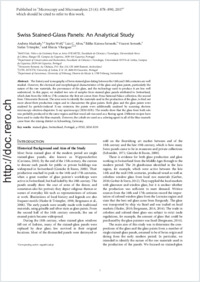Swiss stained-glass panels: an analytical study
- Machado, Andreia R&D Unit, Vidro e da Cerâmica Para as Artes (VICARTE), Faculdade de Ci?ncias e Tecnologia, Universidade Nova de Lisboa, Caparica, Portugal - Department of Conservation and Restoration, Faculdade de Ci?ncias e Tecnologia, Universidade NOVA de Lisboa, Caparica, Portugal
- Wolf, Sophie Vitrocentre Romont, Switzerland
- Alves, Luis C. C2TN, IST/CTN, University of Lisbon, Sacavém, Portugal
- Katona-Serneels, Ildiko Department of Geosciences, University of Fribourg, Switzerland
- Serneels, Vincent Department of Geosciences, University of Fribourg, Switzerland
- Trümpler, Stefan Vitrocentre Romont, Switzerland
- Vilarigues, Márcia R&D Unit, Vidro e da Cerâmica Para as Artes (VICARTE), Faculdade de Ci?ncias e Tecnologia, Universidade Nova de Lisboa, Caparica, Portugal - Department of Conservation and Restoration, Faculdade de Ci?ncias e Tecnologia, Universidade NOVA de Lisboa, Caparica, Portugal
-
23.06.2017
Published in:
- Microscopy and Microanalysis. - 2017, vol. 23, no. 4, p. 878–890
English
The history and iconography of Swiss stained glass dating between the 16th and 18th centuries are well studied. However, the chemical and morphological characteristics of the glass and glass paints, particularly the nature of the raw materials, the provenance of the glass, and the technology used to produce it are less well understood. In this paper, we studied two sets of samples from stained-glass panels attributed to Switzerland, which date from the 16th to 17th centuries: the first set comes from Pena National Palace collection, the second from Vitrocentre Romont. The aims were to identify the materials used in the production of the glass, to find out more about their production origin and to characterize the glass paints. Both glass and the glass paints were analysed by particle-induced X-ray emission; the paints were additionally analysed by scanning electron microscopy–electron-dispersive X-ray spectroscopy (SEM-EDS). The results show that the glass from both sets was probably produced in the same region and that wood ash was used as a fluxing agent. Different recipes have been used to make the blue enamels. However, the cobalt ore used as a coloring agent in all of the blue enamels came from the mining district in Schneeberg, Germany.
- Faculty
- Faculté des sciences et de médecine
- Department
- Département de Géosciences
- Language
-
- English
- Classification
- Medieval and modern history
- License
- License undefined
- Identifiers
-
- RERO DOC 305670
- DOI 10.1017/S1431927617000629
- Persistent URL
- https://folia.unifr.ch/unifr/documents/306061
Statistics
Document views: 95
File downloads:
- see_ssg.pdf: 207
